- Discover Morocco with Photographer Brook Rushton
-

Brook Rushton is an accomplished travel, unit stills and fine art photographer based in Sydney. He has travelled the world shooting for projects like Don’t Be Afraid of the Dark, Tomorrow When the War Began, Killer Elite, Terra Nova, and James Cameron’s Deepsea Challenge 3D. But it was while working in Morocco that Brook discovered his favourite photography destination and fell for the breathtaking landscapes of North Africa.
“First and foremost, Morocco is a total feast for the senses and a paradise for photographers.”
Here in this comprehensive travel guide, Brook reveals his favourite photography locations in Morocco, as well as advice on the best camera gear and settings to use.
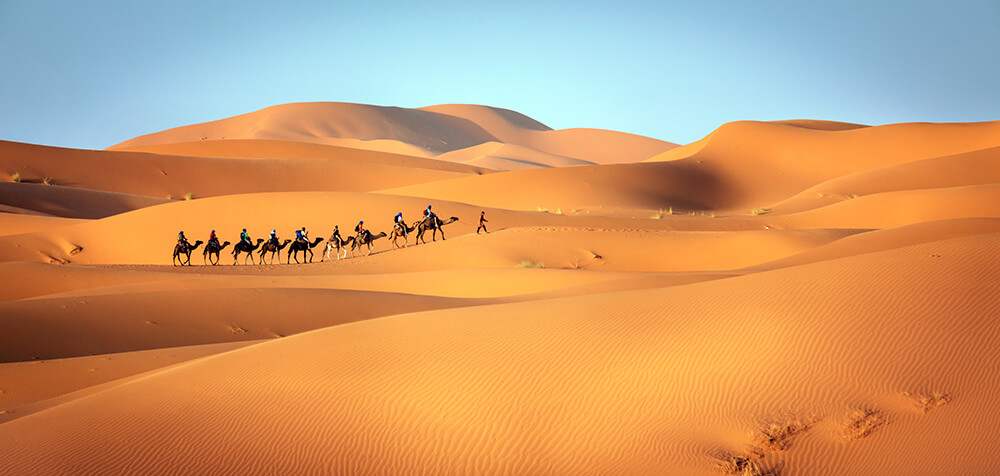
I first visited Morocco in 2008 while working as a photographer for Oscar winning Australian cinematographer John Seale on Disney’s Prince of Persia. My role was to shoot and colour grade reference stills, which were later used to match to the original film captured on 35mm by the Panavision movie cameras.
We shot and travelled for 9 weeks throughout Morocco, from Marrakech to the High Atlas Mountains and then onto the desert of Ouarzazate and Merzouga in the Western Sahara. The experience had a profound effect on me and I knew that one day I would return to experience more of Morocco under my own steam. A few years later I had the opportunity to further explore this incredible country, this time travelling only with my camera and trusted guide.
“Part of the joy of exploring Morocco is the spontaneity of things unfolding before your lens.”
Around every corner you’ll discover intricate mosaics, vivid textures and colours, and inspiring scenes of local life. The atmosphere in this part of the world is fully immersive and it’s easy to become lost in the warmth and bustle of this North African wonderland.
There is a real, palpable sense of magic here that leaves you in a constant state of anticipation. I found the simple act of walking, exploring and discreetly observing to yield many beautiful photographs.
“The key to photographing Morocco is to take your camera everywhere and be ready for fleeting moments of beauty.”
• Aït Benhaddou
“Moroccan Hats” – f/2.8, 1/60 sec, ISO 100
Be sure to add Aït Benhaddou to your Moroccan destination shoot list. This fortified village is a World Heritage listed site and is most famous for featuring in the film Gladiator. Located on the banks of the Ounila River, it has an almost story-book quality and it feels as if you’ve stepped back in time.
“Berber Queen” – f/5.6, 1/125 sec, ISO 250
I made an image overlooking Aït Benhaddou which I call “Berber Queen ”. Standing on the banks of the river, an old local Berber woman came across the steps in front of us and most graciously agreed to stop for a picture. Her wonderful clothes and weather-worn expression told a more personal narrative of life in this incredible place.
Best time to photograph Aït Benhaddou: This is a beautiful spot to shoot at at any time of day, but I particularly enjoyed the warmth of the raking late-afternoon light.
• Chefchaouen
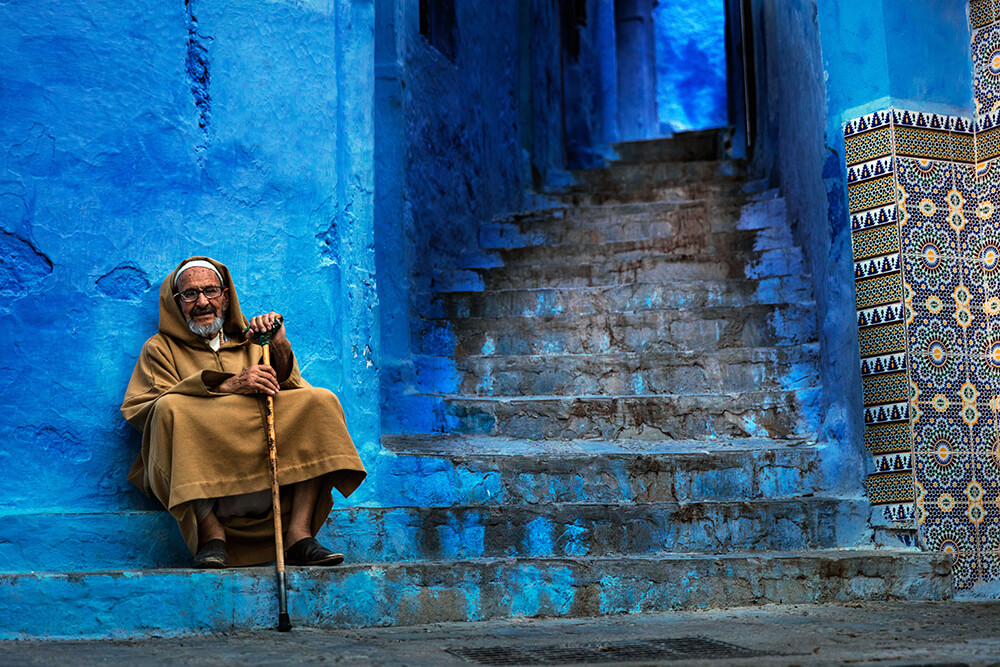
One destination I had always longed to visit was the city of Chefchaouen, also known as the “Blue Pearl ” of Morocco. Perched high in the Rif Mountains, it stood as a remote outpost for Berber tribes for hundreds of years and remained relatively unknown until the 1800s.
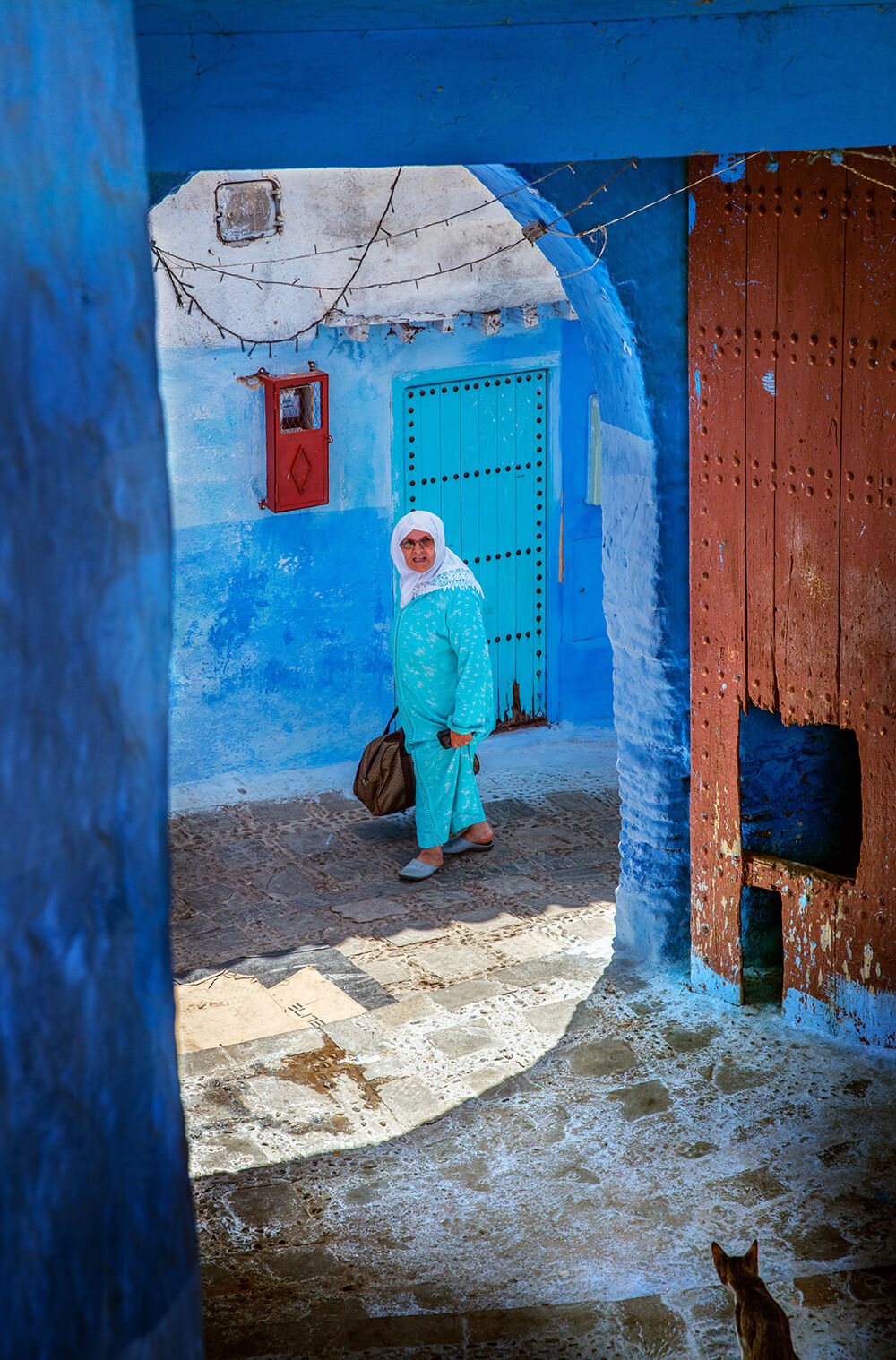
Two mountain peaks, or horns, tower menacingly over the blue-washed walls and twisting maze of alleys, as if to intimidate potential invaders. In fact, the name Chefchaouen literally translates to “Look at the Horns ” and the city sits nestled in their shadow on the hillside below.
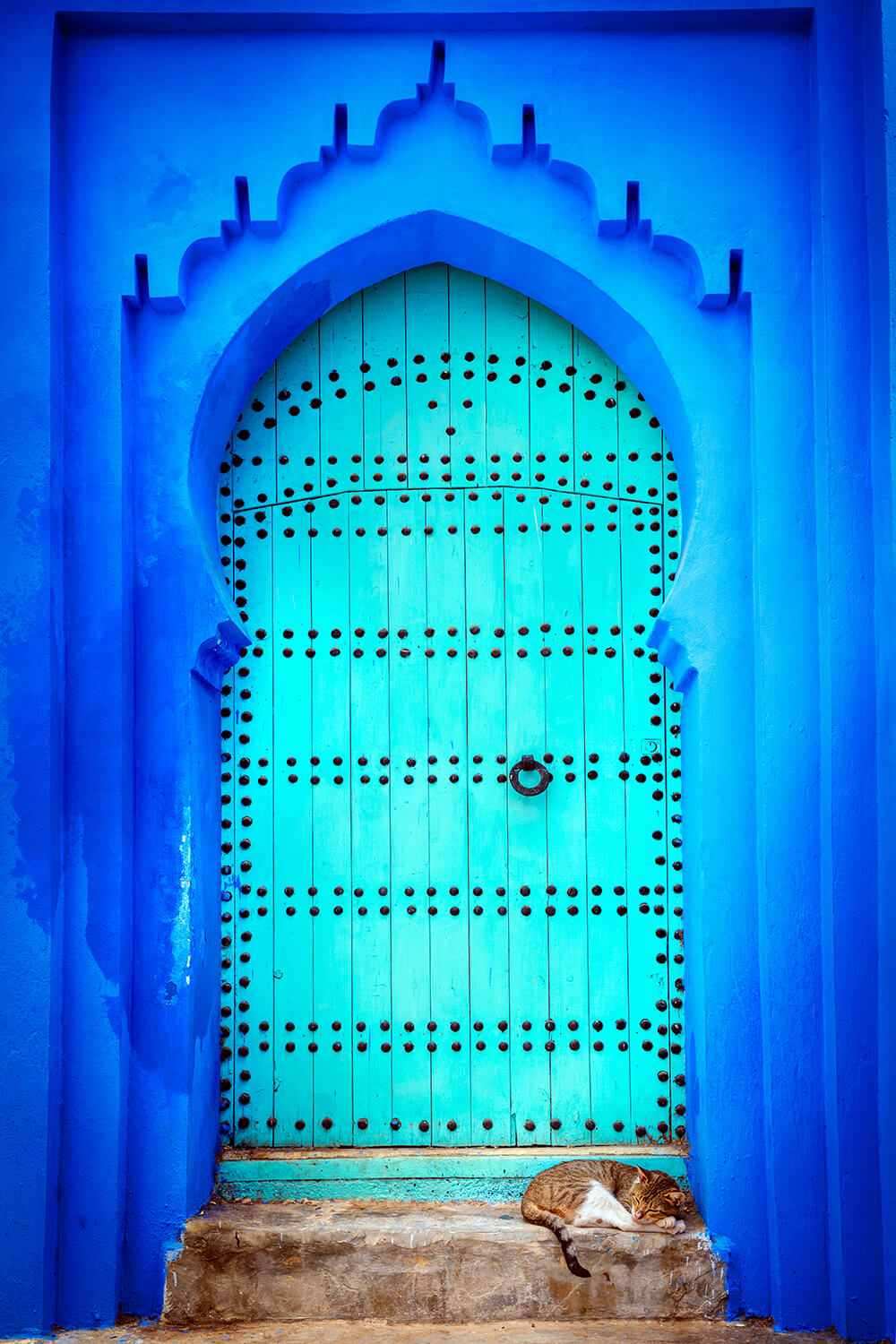
My guide and I stayed in a private house, which had three narrow stories each lined with traditional mosaics and blue tiles in the style of the city itself. The rooftop terrace was a welcome relief from the humidity of the summer heat in the cooler, breezier evenings.
“Every day in Chefchaouen, we happily got lost walking through the tight cobbled laneways, taking in the seemingly endless beautiful doorways and framed arches.”
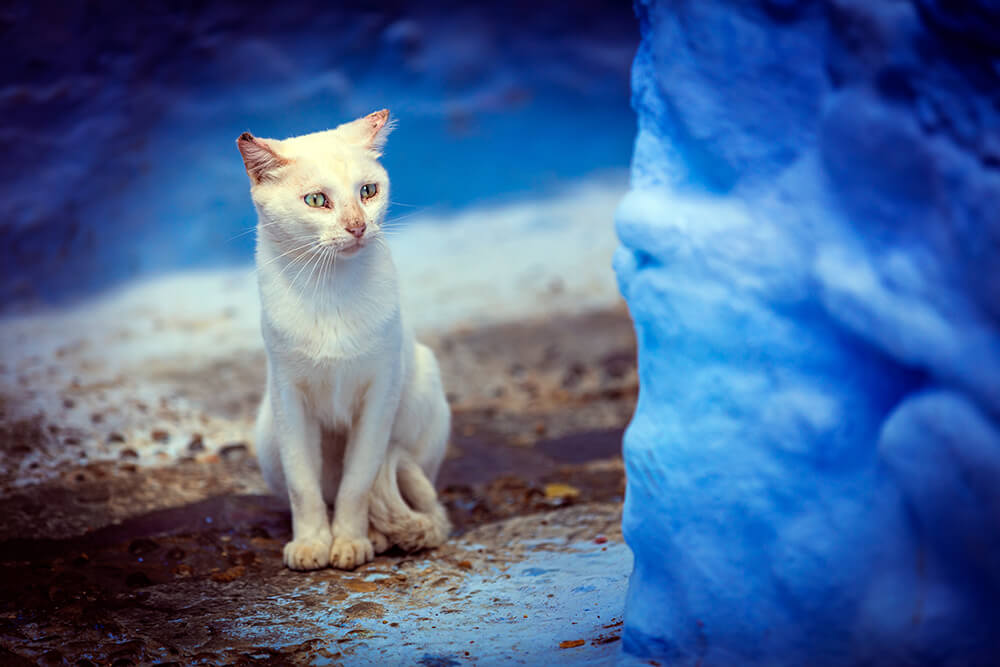
Chefchaouen is famous for its local cat population and there are wonderful opportunities to capture these relaxed locals lounging on the blue steps and sleeping in tucked away nooks.
Best Time to Photograph Chefchaouen: I really enjoyed shooting Chefchaouen in the soft light of early morning, before the tourists arrived. At this time of day you can easily imagine what life was like here hundreds of years ago.
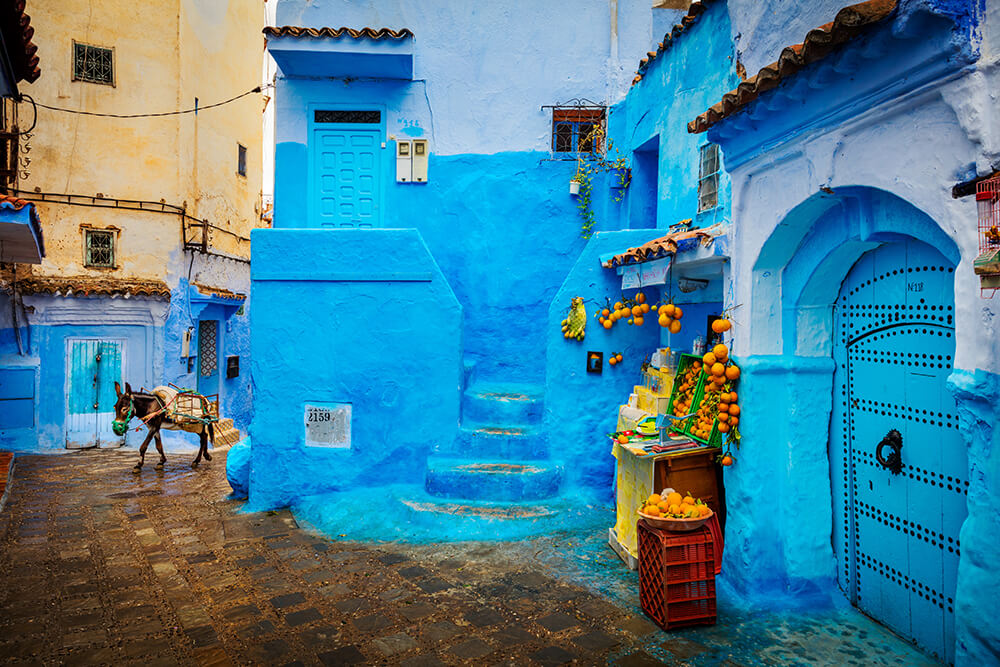
One morning I came across a beautiful set of blue steps which were contrasting with the bright pop of oranges hanging at a street vendor’s stall. As I stood, I could hear the clip-clop of something approaching. Instinctively, I just knew something was going to come around the corner and up to my lens, so I pre-focused on an area of cobblestones to my left. To my absolute delight, a little donkey came up the path and I grabbed what I consider to be my all-time favourite photograph of Morocco.
That feeling of utter jubilation is precisely why I’m a photographer and why knowing your gear and your craft can pay huge dividends when it counts on location.
• Merzouga
“Sands of Time” – f/8, 1/1250 sec, ISO 320
If you want to experience the quintessential Moroccan Sahara experience then a trip to Merzouga is essential. This is the gateway to Erg Chebbi, a vast expanse of sand dunes located near the Algerian border. This is the spot to capture camel caravans walking through shimmering golden sands. Out in this remote area of the Western Sahara, there is a very low standard of living and the people there work hard to survive in the incredibly harsh conditions.
“Saharan Caravan” – f/9, 1/160 sec, ISO 200
Best time to photograph Merzouga: The best light here can be found during dawn and dusk, but there is something about the jaw-dropping beauty of this place that will stay with you no matter what time of day you see it. If you’re really adventurous, take a camel trek into the desert and spend the night amongst the dunes under the stars.
“Heart of Morocco” – f/4, 1/160 sec, ISO 160
• When to go
When planning a trip to Morocco, keep in mind that July and August are the hottest months and temperatures (especially in the desert) can easily reach over 50°C.
• Pack for all types of weather
Morocco has incredibly diverse landscapes and rapidly-changing climates, so be prepared for all types of weather. On one summer day in the Atlas Mountains, we experienced near freezing conditions and torrential rain, only to return to a clear and stifling Marrakech at 35 °C in the same day.
• Plan and prepare
In my experience, preparation is crucial to any successful photography trip. The more prep work you do beforehand, generally the better equipped you are once you hit the ground. I like to have an established vision for the type of images I wish to create, while leaving plenty of room for spontaneity and “happy accidents ”. Do your homework on the regions you wish to visit and you will certainly reap the rewards in your photographs.
• Blend in
Morocco feels very safe, but having a local guide is a bonus. It’s good to have eyes and ears out and remember to always remain vigilant and careful. Locals are typically hospitable and friendly, but it never hurts to have someone close who speaks Arabic or French. It is also culturally expected that you ask permission before taking someone’s photograph.
• Stick with your gear
I never check my camera bag in at the airport and always keep it on me no matter what. Don’t forget to get travel and equipment insurance. If you lose your gear, can you really afford to replace it?
Also expect your equipment to be thoroughly inspected by customs and to be questioned about your intentions. Just be truthful and tell them you’re there to enjoy and explore their beautiful country.
• Leave your drone at home
Morocco has very strict drone laws, so carefully look into the formal permissions required to fly there.
Camera
I travelled throughout Morocco with my workhorse Canon EOS 5DsR 50mp body. I shoot a lot of medium format in my work, but needed something more agile and able to cope with fast moving action while retaining maximum image quality for prints. In my opinion, the 5DSR is one of the few options that come close to medium format quality. Quite simply, I was able to shoot images I couldn’t possibly have achieved using a larger system.
Lenses
• Canon EF 16-35mm f/2.8 II USM – a nice wide angle lens for shooting in tight spaces, such as narrow streets or inside buildings.
• Canon EF 24- 70mm f/2.8 II USM – a great all-round lens with focal lengths suited to everything from portraits to landscapes.
• Canon EF 70-200mm f/2.8 IS II USM – a great focal length for portraits and getting detailed shots of subjects you can’t physically get close to.
Polariser and ND Filters
If I want to shoot long exposures then I’ll use specific 6-stop or 10-stop ND filters and graduated ND filters to help control exposure.
Other Important Gear:
I have a few go-to settings for my travel photography, depending on the type of images I’m producing.
Landscape Images: For straight landscape images, I shoot at 50 ISO, f11 to f16 and wherever the shutter speed falls.
Street/Documentary Photography: For the more street style, documentary work my settings are very different. I try to work to the lowest base ISO I can, but am more comfortable about pushing this higher if it means getting the shot. A good place to start is 320 ISO, f5.6 to f8 and a shutter speed of around a 1/400th of second.
Of course, all this is completely dependent upon light and conditions. I often like to shoot wide open at f2.8 for dreamy depth of field and bokeh in background highlights. Don’t be afraid to experiment here, but understanding the effect of different settings will help you to make better, more informed creative decisions.
Follow Brook Rushton on Instagram or visit his website to see more of his photos from Morocco and beyond.

As 2023 takes a bow, we wrap it up with a cheer. Many moments captured, stories told, a year so grand and dear.

Photograph the best of Peru’s colourful culture and dramatic landscapes with this travel guide from Jordan Hammond

Photographer Benjamin Lee (@itchban) shares his favourite locations in Tokyo and Kyoto, as well as packing advice and tips on how to capture the magic of Japan for yourself.